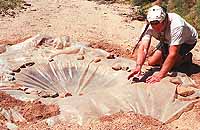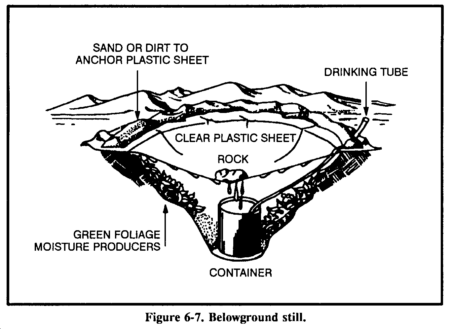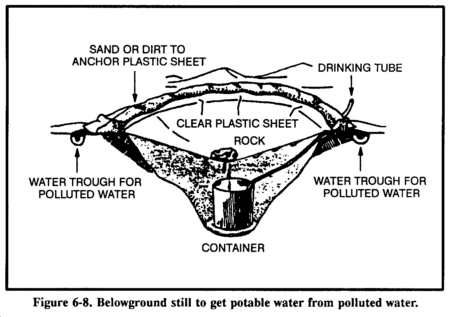The water you save may save you


You need a digging tool, a container, a clear plastic sheet, a drinking
tube, and a rock
- Dig a bowl-shaped hole about 1 meter across and 60 centimeters deep.
- Dig a sump in the center of the hole. The sump's depth and perimeter will depend on the size of the container that you have to place in it. The bottom of the sump should allow the container to stand upright.
- Anchor the tubing to the container's bottom by forming a loose overhand knot in the tubing.
- Place the container upright in the sump.
- Extend the unanchored end of the tubing up, over, and beyond the lip of the hole.
- Place the plastic sheet over the hole, covering its edges with soil to hold it in place.
- Place a rock in the center of the plastic sheet.
- Lower the plastic sheet into the hole until it is about 40 centimeters below ground level. It now forms an inverted cone with the rock at its apex. Make sure that the cone's apex is directly over your container. Also make sure the plastic cone does not touch the sides of the hole because the earth will absorb the condensed water.
- Put more soil on the edges of the plastic to hold it securely in place and to prevent the loss of moisture.
- Plug the tube when not in use so that the moisture will not evaporate.
You can drink water without disturbing the still by using the tube as a straw.
You may want to use plants in the hole as a moisture source. If so, dig out additional soil from the sides of the hole to form a slope on which to place the plants. Then proceed as above.
If polluted water is your only moisture source, dig a small trough outside the hole about 25 centimeters from the still's lip (Figure 6-8). Dig the trough about 25 centimeters deep and 8 centimeters wide. Pour the polluted water in the trough. Be sure you do not spill any polluted water around the rim of the hole where the plastic sheet touches the soil. The trough holds the polluted water and the soil filters it as the still draws it. The water then condenses on the plastic and drains into the container. This process works extremely well when your only water source is salt water.
You will need at least three stills to meet your individual daily water intake needs.
From noahs ark
DEW COLLECTION
In barren areas where there are no trees, it may be possible to collect
sufficient moisture from the grass in the form of dew to preserve life.
One of the easiest way is to tie rags or tufts of fine grass round the
ankles and walk through the herbage before the sun has risen, squeezing
the moisture collected by the rags into a container.
Many explorers saved their life that way. Pig-face and Ice plant and
Pig weed contain large proportions of drinkable moisture.
WATER ON SEA COAST
FRESH WATER CAN ALWAYS BE FOUND ALONG THE SEA COAST BY DIGGING BEHIND
THE WIND BLOWN SAND HILLS WHICH BACK MOST OCEAN BEACHES! These sand
hills trap rain water and it floats on top of the heavier salt water
which filters in from the ocean. Sand hill wells MUST be only deep
enough to uncover the top inch or 2 or water.
SAND WELLS
If dug deeper, salt water will be encountered and the water from the
well will be undrinkable. It will be noticed too that the water in
those wells rises and falls slightly with the tides.
THESE SAND WELLS ARE COMPLETELY RELIABLE SOURCES OF WATER ALL OVER THE
WORLD.
When digging, it is necessary to rivet the sides of the well with
brushwood, otherwise the sand will fall into the well. On coastal areas
where cliffs fall into a sea, careful search along the lower edges of
the cliff will generally disclose soaks or small springs. These, in
general, follow a fault in the rock formation and frequently are
evident by a lush growth of ferns and mosses.
I personally found that near the cliff, at the bottom of them where you
find fallen rocks meeting the sand beach, if you dig there yet not too
close to those rocks, you will find water about 1 foot down. It is a
perpetual source of water, as much as you want, even for 20 persons. It
keeps filling up every day.
MAKE SURE you rivet the side also and just cover the hole with some
planks or drift board and mark it well so that it keeps animals away,
for sand will cover it fast after a while from the nearby sand hill.
I know about them I survived on them for 5 months on a deserted island.
Brion Island. QC.
CONDENSING SALT WATER
It is possible to condense sea water without equipment and obtain
sufficient fresh water.
A coolamon is made or alternatively a hole is scraped in the ground and
lined. The salt water is put into this hole. A fire is built and stones
are put into it to heat up. These, when hot, are put into the salted
water which soon boils and then water vapor is soaked up by a towel or
thick mat of cloth.
In time, this will become literally saturated and may be wrung out,
yielding a fair quantity of fresh drinkable water. Once the cloth is
cool the collection of water vapor is fairly rapid.
MOISTURE CONDENSATION IN ARID AREAS
This still produces about 50% more water between 8pm.. and 8 am. than
during the day, but it still works day and night. DonÕt depend
to drink this water immediately for it takes 24 hours before collecting
1 quart (1 litre) of water sometimes.
A simple still for water condensation in arid areas can be made from a
piece of light plastic sheeting about 4 feet (122cm) square. A clean
garbage bag which has been fully cut and open will do. A hole is dug in
the ground in a sunny position. The hole should be about 3 feet (1
meter) across and 15Ó to 18" (38cm - 46cm) deep or deeper if
possible.
The site should be preferably in a moist ground, a depression in a
creek bed is ideal if one can be found. If green material such as
shrubs or succulent herbage is nearby, the hole should be lined with
this and the materials packed down. It may be necessary to weigh down
the material with a few flat stones. In the centre of the hole and in
the deepest part, a container is placed to catch the moisture from
condensation.
Lay the sheet of plastic across and covering the hole using some of the
earth scooped from the hole to seal the edges lightly.
Place a stone in the centre of the upper side of the plastic sheet
above the approximate centre of the water container to weigh it down to
just over the container below.
Moisture in the soil and in the greenery placed in the hole will be
drawn off by the heat of the sun and condense on the underside of the
plastic. The condensed moisture will collect into droplets, coalesce
and trickle down the underside to the lowest point where it drops off
into the container.
If the underside of the plastic sheet is slightly roughened with fine
sandpaper or similar fine abrasive such as a piece of finely grained
stone, the droplets will coalesce and run off more cleanly than if the
underside is absolutely smooth.
Body waste such as urine, waste food, moist tea leaves etc. can be put
into the hole. The pure moisture only is condensed. From 1 - 4 pints of
water a day can be collected by this method.
If the stay in the area is likely to be of some duration the top few
inches of the hole can be removed and fresh green material replaced and
the still will continue to work when this is done.
FRESH STILL SITES MAY BE NECESSARY EVERY 2ND OR 3RD DAY.
This still can also bring you food! Since water under the plastic will
attract snakes and small games which will crawl under the still cone
but can not go out.
This effective method was first used by the Water Conservation
Laboratory in Arizona.
It is not necessary, but very useful, if you have a flexible plastic
tube about 1.5m long which will permit you to drink from the bottom
bucket without having to remove it and stopping the recuperation.
Collecting Rain, Condensation and Dew
Nature can also provide you with water in the form of rain, condensation and dew. You can collect this moisture to use as a water source. In the case of rain, use as big a catchment area as possible, running the water off into containers. A covered hole in the ground lined with clay will hold water. If you have no impermeable sheeting, use metal sheets or bark to collect the water. Dew is the moisture that appears on the grass or plants over night. As the ground cools the water vapour condenses and is deposited on the surface of plants. You can also use cloth to soak up this water. Tie clean strips of around your legs and walk through wet vegetation. These cloths can then be sucked to remove t the water.
You can also collect the water vapour that is given off by plants as they photosynthesize. Trees can draw moisture from a water table 15 meters or more below the surface. Far too deep for you to dig. So let the tree pump the water for you.
- Select a healthy, green, leafy branch that you can reach easily.
- Enclose as much of the leafy vegetation on the end of the branch as you can into a plastic bag and tie it closed around the branch.
- Water that evaporates from the leaves will condense on the inside of the bag.
- Make sure that one corner of the bag hangs lower than the rest of the bag. The water droplets will collect in this corner of the bag.
- This is pure water that can be used for drinking.

 De landbouwers op het Eiland Lanzerotte (een van de Canarische Eilanden
voor de kust van Afrika) hebben geleerd druiven en vijgen te verbouwen
in gebeiden waar praktisch geen regenval is.
De landbouwers op het Eiland Lanzerotte (een van de Canarische Eilanden
voor de kust van Afrika) hebben geleerd druiven en vijgen te verbouwen
in gebeiden waar praktisch geen regenval is.